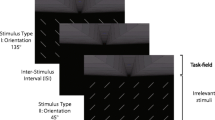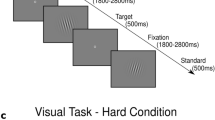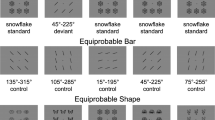Abstract
In a visual oddball task the presentation of rare targets induces a prolonged microsaccadic inhibition as compared to standards. Here, we replicated this effect also in the auditory modality. In addition, although auditory standards induced a more limited modulation of microsaccadic frequency as compared to visual standards, auditory oddballs induced a prolonged microsaccadic inhibition. With bimodal standard stimuli the microsaccadic response was determined by the attended modality, resembling that produced by attended unimodal stimuli. The present findings support the idea that the microsaccadic response to oddball and standard stimuli is partly driven by cognitive mechanisms common to both the visual and the auditory modality, and that microsaccades can be used as an implicit behavioral measure of ongoing cognitive processes.



Similar content being viewed by others
References
Benjamini, Y., & Yekutieli, D. (2001). The control of the false discovery rate in multiple testing under dependency. Annals of Statistics, 29, 1165–1188.
Bennington, J.Y., & Polich, J. (1999). Comparison of P300 from passive and active tasks for auditory and visual stimuli. International Journal of Psychophysiology, 34, 171–177.
Besle, J., Fort, A., & Giard, M. H. (2005). Is the auditory sensory memory sensitive to visual information? Experimental Brain Research, 166, 337–344.
Betta, E., & Turatto, M. (2006). Are you ready? I can tell by looking at your microsaccades. Neuroreport, 17, 1001–1004.
Betta, E., Galfano, G., & Turatto, M. (2007). Microsaccadic response during inhibition of return in a target-target paradigm. Vision Research, 47, 428–436.
Brainard, D.H. (1997). The psychophysics toolbox. Spatial Vision, 10, 433–436.
Bridgeman, B. (1998). Durations of stimuli displayed on video display terminals: (n − 1)/f + Persistence. Psychological Science, 9, 232–233.
Brown, C. R., Clarke, A. R., & Barry, R. J. (2006). Inter-modal attention: ERPs to auditory targets in an inter-modal oddball task. International Journal of Psychophysiology, 62, 77–86.
Brown, C. R., Clarke, A. R., & Barry, R. J. (2007). Auditory processing in an inter-modal oddball task: effects of a combined auditory/visual standard on auditory target ERPs. International Journal of Psychophysiology, 65, 122–131.
Busse, L., Roberts, K. C., Crist, R. E., Weissman, D. H., & Woldorff, M. G. (2005). The spread of attention across modalities and space in a multisensory object. Proceedings of the National Academy of Sciences of the USA, 102, 18751–18756.
Cornsweet, T. N. (1956). Determination of the stimuli for involuntary drifts and saccadic eye movements. Journal of the Optical Society of America, 46, 987–993.
Ditchburn, R. W. (1980). The function of small saccades. Vision Research, 20, 271–272.
Ditchburn, R. W., Fender, D. H., & Mayne, S. (1959). Vision with controlled movements of the retinal image. Journal of Physiology (London), 145, 98–107.
Donchin, E., & Coles, M. G. H. (1988). Is the P300 component a manifestation of context updating? Behavioral and Brain Sciences, 11, 357–427.
Engbert, R. (2006). Microsaccades: a microcosm for research on oculomotor control, attention, and visual perception. Progress in Brain Research, 154, 179–194.
Engbert, R., & Kliegl, R. (2003). Microsaccades uncover the orientation of covert attention. Vision Research, 43, 1035–1045.
Engbert, R., & Kliegl, R. (2004). Microsaccades keep the eyes’ balance during fixation. Psychological Science, 15, 431–436.
Engbert, R., & Mergenthaler, K. (2006). Microsaccades are triggered by low retinal slip. Proceedings of the National Academy of Sciences of the USA, 103, 7192–8197.
Galfano, G., Betta, E., & Turatto, M. (2004). Inhibition of return in microsaccades. Experimental Brain Research, 159, 400–404.
Gescheider, G. A. (1988). Psychophysical scaling. Annual Reviews of Psychology, 39, 169–200.
Hafed, Z. M., & Clark, J. J. (2002). Microsaccades as an overt measure of covert attention shifts. Vision Research, 42, 2533–2545.
Hillyard, S. A., Hink, R. F., Schwent, V. L., & Picton, T. W. (1973). Electrical signs of selective attention in the human brain. Science, 182, 177–180.
Horowitz, T. S., Fine, E. M., Fencsik, D. E., Yurgenson, S., & Wolfe, J. M. (2007). Fixational eye movements are not an index of covert attention. Psychological Science, 18, 356–363.
Jiang, W., Wallace, M. T., Jiang, H., Vaughan, J. W., & Stein, B. E. (2001). Two cortical areas mediate multisensory integration in superior collicuclus neurons. Journal of Neurophysiology, 85, 506–522.
Katayama, J., & Polich, J. (1999). Auditory and visual P300 topography from a 3 stimulus paradigm. Clinical Neurophysiology, 110, 463–468.
Kok, A. (2001). On the utility of P3 amplitude as a measure of processing capacity. Psychophysiology, 38, 557–577.
Kowler, E., & Steinman, R. M. (1980). Small saccades serve no useful purpose: reply to a letter by R.W. Ditchburn. Vision Research, 20, 273–276.
Laubrock, J., Engbert, R., & Kliegl, R. (2005). Microsaccade dynamics during covert attention. Vision Research, 45, 721–730.
Laubrock, J., Engbert, R., Rolfs, M., & Kliegl, R. (2007). Microsaccades are an index of covert attention: commentary on Horowitz, Fine, Fencsik, Yurgenson, and Wolfe (2007). Psychological Science, 18, 364–366.
Marks, L. E., Szczesiul, R., & Ohlott, P. (1986). On the cross-modal perception of intensity. Journal of Experimental Psychology: Human Perception and Performance, 12, 517–534.
Martinez-Conde, S., Macknik, S. L., & Hubel, D. H. (2000). Microsaccadic eye movements and firing of single cells in the striate cortex of macaque monkeys. Nature Neuroscience, 3, 251–258.
Martinez-Conde, S., Macknik, S. L., & Hubel, D. H. (2002). The function of bursts of spikes during visual fixation in the awake primate lateral geniculate nucleus and primary visual cortex. Proceedings of the National Academy of Sciences of the USA, 99, 13920–13925.
Martinez-Conde, S., Macknik, S. L., & Hubel, D. H. (2004). The role of fixational eye movements in visual perception. Nature Reviews Neuroscience, 5, 229–240.
Martinez-Conde, S., Macknik, S. L., Troncoso, X. G., & Dyar, T. A. (2006). Microsaccades counteract visual fading during fixation. Neuron, 49, 297–305.
Mergenthaler, K., & Engbert, R. (2007). Modeling the control of fixational eye movements with neurophysiological delays. Physical Review Letters, 98, 138104.
Näätänen, R., Gaillard, A. W. K., & Mäntysalo, S. (1978). Early selective-attention effect on evoked potential reinterpreted. Acta Psychologica, 42, 313–329.
Perrault, T. J., Vaughan, J. W., Stein, B. E., & Wallace, M. T. (2005). Superior colliculus neurons use distinct operational modes in the integration of multisensory stimuli. Journal of Neurophysiology, 93, 2575–2586.
Robinson, D. A. (1972). Eye movements evoked by collicular stimulation in the alert monkey. Vision Research, 12, 1795–1808.
Rolfs, M., Engbert, R., & Kliegl, R. (2004). Microsaccade orientation supports attentional enhancement opposite to a peripheral cue: commentary on Tse, Sheinberg and Logothetis. Psychological Science, 15, 705–707.
Rolfs, M., Engbert, R., & Kliegl, R. (2005). Crossmodal coupling of oculomotor control and spatial attention in vision and audition. Experimental Brain Research, 166, 427–439.
Rolfs, M., Laubrock, J., & Kliegl, R. (2006). Shortening and prolongation of saccade latencies following microsaccades. Experimental Brain Research, 169, 369–376.
Sparks, D. L. (1986). Translation of sensory signals into commands for control of saccadic eye movements: role of primate superior colliculus. Physiological Reviews, 66, 118–171.
Stein, B. E., Wallace, M. W., Stanford, T. R., & Jiang, W. (2002). Cortex governs multisensory integration in the midbrain. The Neuroscientist, 8, 306–314.
Steinman, R. M., Haddad, G. M., Skavenski, A. A., & Wyman, D. (1973). Miniature eye movement. Science, 181, 810–819.
Turatto, M., Valsecchi, M., Tamè, L., & Betta, E. (2007). Microsaccades distinguish between global and local visual processing. Neuroreport, 18, 1015–1018.
Ulrich, R., & Miller, J. (2001). Using the jackknife-based scoring method for measuring LRP onset effects in factorial designs. Psychophysiology, 38, 816–827.
Valsecchi, M., & Turatto, M. (2007). Microsaccadic response to visual events that are invisible to the Superior Colliculus. Behavioral Neuroscience, 121, 786–793.
Valsecchi, M., Betta, E., & Turatto, M. (2007). Visual oddballs induce prolonged microsaccadic inhibition. Experimental Brain Research, 177, 196–208.
Verleger, R. (1988). Event-related potentials and cognition: a critique of the context updating hypothesis and an alternative interpretation of P3. Behavioral and Brain Sciences, 11, 343–356.
Wallace, M. T., Meredith, M. A., & Stein, B. E. (1993). Converging evidence from visual, auditory, and somatosensory cortices onto output neurons of the superior colliculus. Journal of Neurophysiology, 69, 1797–1809.
Wyszecki, G., & Stiles, W. S. (1982). Color science: concepts and methods, quantitative data and formulae. (2nd ed.) New York: John Wiley & Sons, Inc.
Zuber, B. L., Stark, L., & Cook, M. (1965). Microsaccades and the velocity-amplitude relationship for saccadic eye movements. Science, 150, 1459–1460.
Author information
Authors and Affiliations
Corresponding author
Rights and permissions
About this article
Cite this article
Valsecchi, M., Turatto, M. Microsaccadic responses in a bimodal oddball task. Psychological Research 73, 23–33 (2009). https://doi.org/10.1007/s00426-008-0142-x
Received:
Accepted:
Published:
Issue Date:
DOI: https://doi.org/10.1007/s00426-008-0142-x




